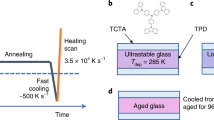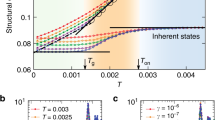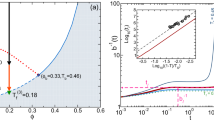Abstract
The glass transition, extensively studied in dense fluids, polymers or colloids, corresponds to a marked evolution of equilibrium transport coefficients on a modest change of control parameter, such as temperature or pressure. A similar phenomenology is found in many systems evolving far from equilibrium, such as driven granular media, active and living matter. Although many theories compete to describe the glass transition at thermal equilibrium, very little is understood far from equilibrium. Here, we solve the dynamics of a specific, yet representative, class of glass models in the presence of non-thermal driving forces and energy dissipation, and show that a dynamic arrest can take place in these non-equilibrium conditions. Whereas the location of the transition depends on the specifics of the driving mechanisms, important features of the glassy dynamics are insensitive to details, suggesting that an effective thermal dynamics generically emerges at long timescales in non-equilibrium systems close to dynamic arrest.
This is a preview of subscription content, access via your institution
Access options
Subscribe to this journal
Receive 12 print issues and online access
$209.00 per year
only $17.42 per issue
Buy this article
- Purchase on Springer Link
- Instant access to full article PDF
Prices may be subject to local taxes which are calculated during checkout


Similar content being viewed by others
References
Marty, G. & Dauchot, O. Subdiffusion and cage effect in a sheared granular material. Phys. Rev. Lett. 94, 015701 (2005).
Reis, P. M., Ingale, R. A. & Shattuck, M. D. Caging dynamics in a granular fluid. Phys. Rev. Lett. 98, 188301 (2007).
Watanabe, K. & Tanaka, H. Direct observation of medium-range crystalline order in granular liquids near the glass transition. Phys. Rev. Lett. 100, 158002 (2008).
Abate, A. R. & Durian, D. J. Approach to jamming in an air-fluidized granular bed. Phys. Rev. E 74, 031308 (2006).
Kranz, T., Sperl, M. & Zippelius, A. Glass transition for driven granular fluids. Phys. Rev. Lett. 104, 225701 (2010).
Palacci, J., Cottin-Bizonne, C., Ybert, C. & Bocquet, L. Sedimentation and effective temperature of active colloidal suspensions. Phys. Rev. Lett. 105, 088304 (2010).
Theurkauff, I., Cottin-Bizonne, C., Palacci, J., Ybert, C. & Bocquet, L. Dynamic clustering in active colloidal suspensions with chemical signalling. Phys. Rev. Lett. 108, 268303 (2012).
Deseigne, J., Dauchot, O. & Chaté, H. Collective motion of vibrated polar disks. Phys. Rev. Lett. 105, 135702 (2010).
Angelini, T. E. et al. Glass-like dynamics of collective cell migration. Proc. Natl Acad. Sci. USA 108, 4714–4719 (2011).
Petitjean, L. et al. Velocity fields in a collectively migrating epithelium. Biophys. J. 98, 1790–1800 (2010).
Loi, D., Mossa, S. & Cugliandolo, L. F. Non-conservative forces and effective temperatures in active polymers. Soft Matter 7, 10193–10209 (2011).
Loi, D., Mossa, S. & Cugliandolo, L. F. Effective temperature of active complex matter. Soft Matter 7, 3726–3729 (2011).
Henkes, S., Fily, Y. & Marchetti, M. C. Active jamming: Self-propelled soft particles at high density. Phys. Rev. E 84, 040301(R) (2011).
Bialké, J., Speck, T. & Löwen, H. Crystallization in a dense suspension of self-propelled particles. Phys. Rev. Lett. 108, 168301 (2012).
Tailleur, J. & Cates, M. E. Statistical mechanics of interacting run-and-tumble bacteria. Phys. Rev. Lett. 100, 218103 (2008).
Tailleur, J. & Cates, M. E. Sedimentation, trapping, and rectification of dilute bacteria. EPL 86, 60002 (2009).
Marchetti, M. C. et al. Soft active matter. Preprint at http://arxiv.org/abs/1207.2929 (2012).
Berthier, L. & Biroli, G. Theoretical perspective on the glass transition and amorphous materials. Rev. Mod. Phys. 83, 587–645 (2011).
Wang, S. & Wolynes, P. G. Effective temperature and glassy dynamics of active matter. J. Chem. Phys. 135, 051101 (2011).
Kirkpatrick, T. R. & Thirumalai, D. Dynamics of the structural glass transition and the p-spin interaction spin glass model. Phys. Rev. Lett. 58, 2091–2094 (1987).
Kirkpatrick, T. R., Thirumalai, D. & Wolynes, P. G. Scaling concepts for the dynamics of viscous liquids near an ideal glassy state. Phys. Rev. A 40, 1045–1054 (1989).
Prost, J., Joanny, J-F. & Parrondo, J. M. R. Generalized fluctuation–dissipation theorem for steady-state systems. Phys. Rev. Lett. 103, 090601 (2009).
Bohec, P. et al. Probing active forces via a fluctuation–dissipation relation. Preprint at http://arxiv.org/abs/1203.3571 (2012).
Ben-Isaac, E. et al. Effective temperature of red-blood-cell membrane fluctuations. Phys. Rev. Lett. 106, 238103 (2011).
Gopinath, A., Hagan, M. F., Marchetti, M. C. & Baskaran, A. Dynamical self-regulation in self-propelled particle flows. Phys. Rev. E 85, 061903 (2012).
Dammak, H., Chalopin, Y., Laroche, M., Hayoun, M. & Greffet, J-J. Quantum thermal bath for molecular dynamics simulation. Phys. Rev. Lett. 103, 190601 (2009).
Ford, G. W., Lewis, J. T. & O’Connell, R. F. Quantum Langevin equation. Phys. Rev. A 37, 4419–4428 (1988).
Cugliandolo, L. F. & Kurchan, J. A scenario for the dynamics in the small entropy production limit. J. Phys. Soc. Jpn 69 (Suppl. A), 247–256 (2000).
Berthier, L., Barrat, J-L. & Kurchan, J. A two-timescale, two-temperature scenario for nonlinear rheology. Phys. Rev. E 61, 5464–5472 (2000).
Berthier, L., Cugliandolo, L. F. & Iguain, J. L. Glassy systems under time-dependent driving forces: Application to slow granular rheology. Phys. Rev. E 63, 051302 (2001).
Götze, W. Complex Dynamics of Glass-Forming Liquids: A Mode-Coupling Theory (Oxford Univ. Press, 2008).
Cugliandolo, L. F., Kurchan, J. & Peliti, L. Energy flow, partial equilibration, and effective temperatures in systems with slow dynamics. Phys. Rev. E 55, 3898–3914 (1997).
Cugliandolo, L. F. & Kurchan, J. Analytical solution of the off-equilibrium dynamics of a long-range spin-glass model. Phys. Rev. Lett. 71, 173–176 (1993).
Kurchan, J. Emergence of macroscopic temperatures in systems that are not thermodynamical microscopically: Towards a thermodynamical description of slow granular rheology. J. Phys. Condens. Matter 12, 6611–6617 (2000).
Berthier, L., Holdsworth, P. C. W. & Sellitto, M. Nonequilibrium critical dynamics of the 2D XY model. J. Phys. A 34, 1805–1824 (2001).
Cugliandolo, L. F., Grempel, D. R. & da Silva Santos, C. From second to first order transitions in a disordered quantum magnet. Phys. Rev. Lett. 85, 2589–2592 (2000).
Chorin, A. J., Hald, O. H. & Kupferman, R. Optimal prediction and the Mori-Zwanzig representation of irreversible processes. Proc. Natl Acad. Sci. USA 97, 2968–2973 (2000).
Brader, J. M. et al. Nonlinear response of dense colloidal suspensions under oscillatory shear: Mode-coupling theory and Fourier transform rheology experiments. Phys. Rev. E 82, 061401 (2010).
Daniels, L. J., Haxton, T. K., Xu, N., Liu, A. J. & Durian, D. J. Temperature–pressure scaling for air-fluidized grains on approaches to Point J. Phys. Rev. Lett. 108, 138001 (2012).
Acknowledgements
We thank E. Bertin and O. Dauchot for discussions, and Groupement de Recherches PHENIX and ANR programme JAMVIB for partial financial support. The research leading to these results has received financial support from the European Research Council under the European Union’s Seventh Framework Programme (FP7/2007-2013)/ERC Grant agreement No 306845.
Author information
Authors and Affiliations
Contributions
Both authors contributed equally to this work.
Corresponding author
Ethics declarations
Competing interests
The authors declare no competing financial interests.
Rights and permissions
About this article
Cite this article
Berthier, L., Kurchan, J. Non-equilibrium glass transitions in driven and active matter. Nature Phys 9, 310–314 (2013). https://doi.org/10.1038/nphys2592
Received:
Accepted:
Published:
Issue Date:
DOI: https://doi.org/10.1038/nphys2592
This article is cited by
-
Unconventional colloidal aggregation in chiral bacterial baths
Nature Physics (2023)
-
Matrix viscoelasticity controls spatiotemporal tissue organization
Nature Materials (2023)
-
Dynamic and reconfigurable materials from reversible network interactions
Nature Reviews Materials (2022)
-
Selective and collective actuation in active solids
Nature Physics (2022)
-
Unjamming and emergent nonreciprocity in active ploughing through a compressible viscoelastic fluid
Nature Communications (2022)



